2017 NISSAN ROGUE light
[x] Cancel search: lightPage 56 of 82
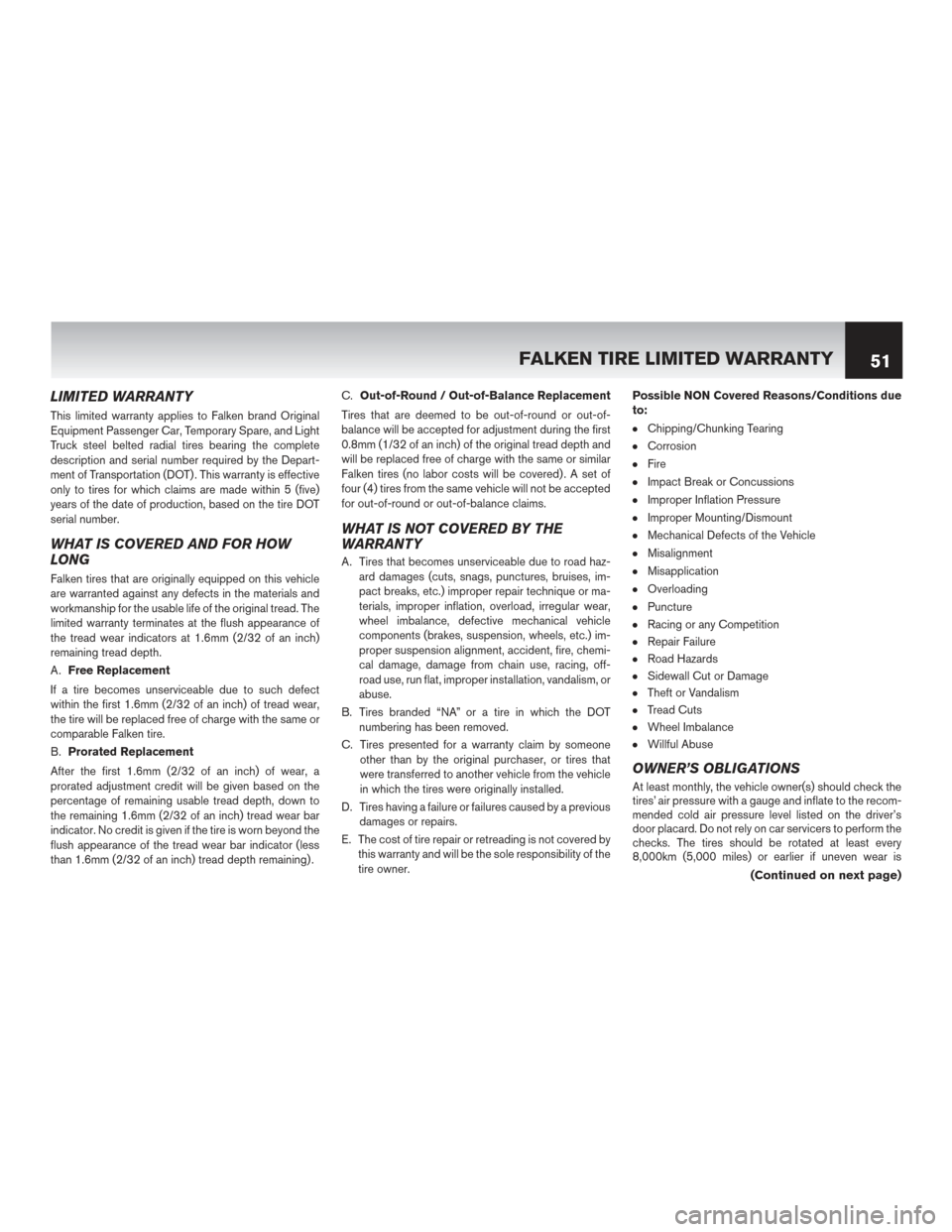
LIMITED WARRANTY
This limited warranty applies to Falken brand Original
Equipment Passenger Car, Temporary Spare, and Light
Truck steel belted radial tires bearing the complete
description and serial number required by the Depart-
ment of Transportation (DOT) . This warranty is effective
only to tires for which claims are made within 5 (five)
years of the date of production, based on the tire DOT
serial number.
WHAT IS COVERED AND FOR HOW
LONG
Falken tires that are originally equipped on this vehicle
are warranted against any defects in the materials and
workmanship for the usable life of the original tread. The
limited warranty terminates at the flush appearance of
the tread wear indicators at 1.6mm (2/32 of an inch)
remaining tread depth.
A.Free Replacement
If a tire becomes unserviceable due to such defect
within the first 1.6mm (2/32 of an inch) of tread wear,
the tire will be replaced free of charge with the same or
comparable Falken tire.
B. Prorated Replacement
After the first 1.6mm (2/32 of an inch) of wear, a
prorated adjustment credit will be given based on the
percentage of remaining usable tread depth, down to
the remaining 1.6mm (2/32 of an inch) tread wear bar
indicator. No credit is given if the tire is worn beyond the
flush appearance of the tread wear bar indicator (less
than 1.6mm (2/32 of an inch) tread depth remaining) . C.
Out-of-Round / Out-of-Balance Replacement
Tires that are deemed to be out-of-round or out-of-
balance will be accepted for adjustment during the first
0.8mm (1/32 of an inch) of the original tread depth and
will be replaced free of charge with the same or similar
Falken tires (no labor costs will be covered) . A set of
four (4) tires from the same vehicle will not be accepted
for out-of-round or out-of-balance claims.
WHAT IS NOT COVERED BY THE
WARRANTY
A. Tires that becomes unserviceable due to road haz- ard damages (cuts, snags, punctures, bruises, im-
pact breaks, etc.) improper repair technique or ma-
terials, improper inflation, overload, irregular wear,
wheel imbalance, defective mechanical vehicle
components (brakes, suspension, wheels, etc.) im-
proper suspension alignment, accident, fire, chemi-
cal damage, damage from chain use, racing, off-
road use, run flat, improper installation, vandalism, or
abuse.
B. Tires branded “NA” or a tire in which the DOT numbering has been removed.
C. Tires presented for a warranty claim by someone other than by the original purchaser, or tires that
were transferred to another vehicle from the vehicle
in which the tires were originally installed.
D. Tires having a failure or failures caused by a previous damages or repairs.
E. The cost of tire repair or retreading is not covered by this warranty and will be the sole responsibility of the
tire owner. Possible NON Covered Reasons/Conditions due
to:
●Chipping/Chunking Tearing
●Corrosion
●Fire
●Impact Break or Concussions
●Improper Inflation Pressure
●Improper Mounting/Dismount
●Mechanical Defects of the Vehicle
●Misalignment
●Misapplication
●Overloading
●Puncture
●Racing or any Competition
●Repair Failure
●Road Hazards
●Sidewall Cut or Damage
●Theft or Vandalism
●Tread Cuts
●Wheel Imbalance
●Willful Abuse
OWNER’S OBLIGATIONS
At least monthly, the vehicle owner(s) should check the
tires’ air pressure with a gauge and inflate to the recom-
mended cold air pressure level listed on the driver’s
door placard. Do not rely on car servicers to perform the
checks. The tires should be rotated at least every
8,000km (5,000 miles) or earlier if uneven wear is
(Continued on next page)
FALKEN TIRE LIMITED WARRANTY
51
Page 58 of 82
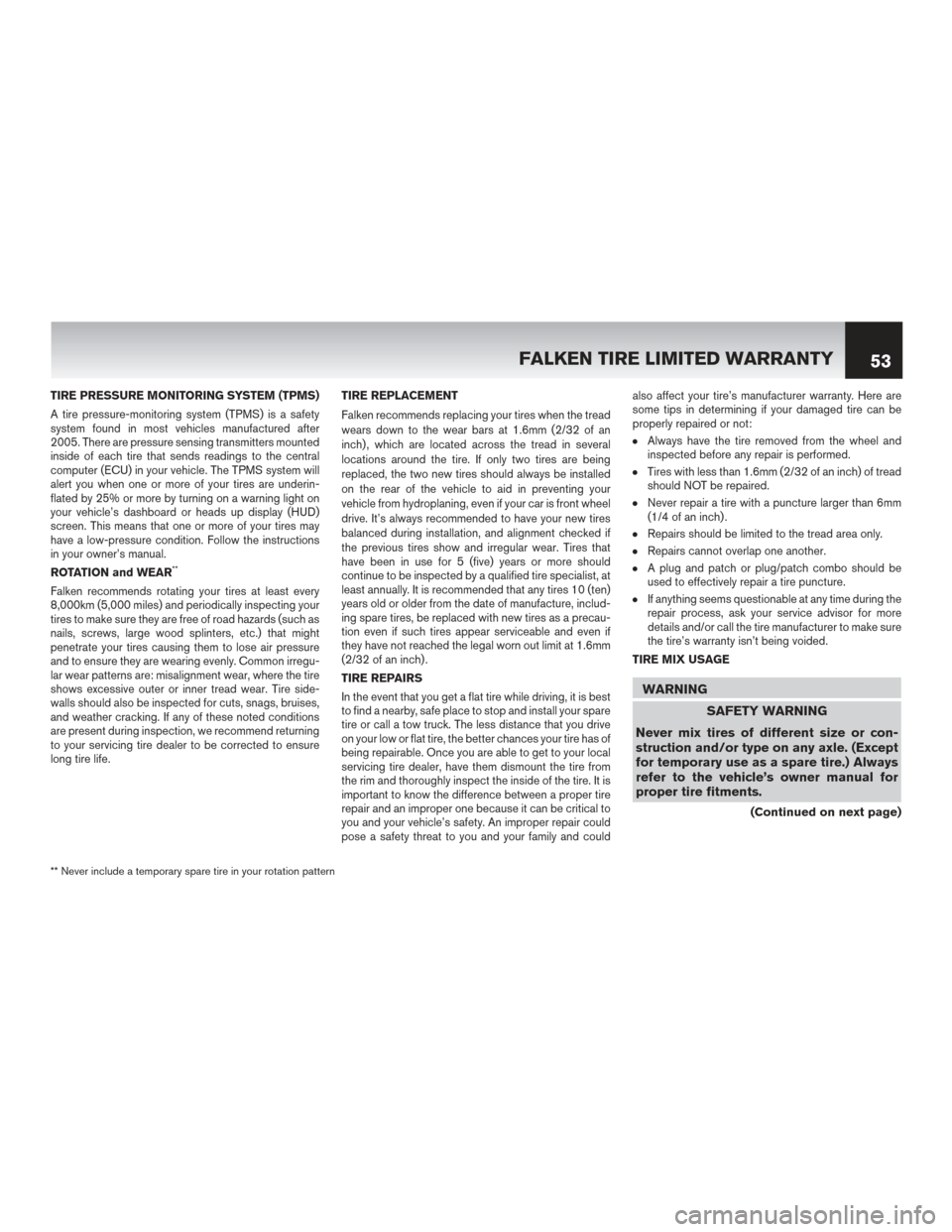
TIRE PRESSURE MONITORING SYSTEM (TPMS)
A tire pressure-monitoring system (TPMS) is a safety
system found in most vehicles manufactured after
2005. There are pressure sensing transmitters mounted
inside of each tire that sends readings to the central
computer (ECU) in your vehicle. The TPMS system will
alert you when one or more of your tires are underin-
flated by 25% or more by turning on a warning light on
your vehicle’s dashboard or heads up display (HUD)
screen. This means that one or more of your tires may
have a low-pressure condition. Follow the instructions
in your owner’s manual.
ROTATION and WEAR
**
Falken recommends rotating your tires at least every
8,000km (5,000 miles) and periodically inspecting your
tires to make sure they are free of road hazards (such as
nails, screws, large wood splinters, etc.) that might
penetrate your tires causing them to lose air pressure
and to ensure they are wearing evenly. Common irregu-
lar wear patterns are: misalignment wear, where the tire
shows excessive outer or inner tread wear. Tire side-
walls should also be inspected for cuts, snags, bruises,
and weather cracking. If any of these noted conditions
are present during inspection, we recommend returning
to your servicing tire dealer to be corrected to ensure
long tire life.TIRE REPLACEMENT
Falken recommends replacing your tires when the tread
wears down to the wear bars at 1.6mm (2/32 of an
inch) , which are located across the tread in several
locations around the tire. If only two tires are being
replaced, the two new tires should always be installed
on the rear of the vehicle to aid in preventing your
vehicle from hydroplaning, even if your car is front wheel
drive. It’s always recommended to have your new tires
balanced during installation, and alignment checked if
the previous tires show and irregular wear. Tires that
have been in use for 5 (five) years or more should
continue to be inspected by a qualified tire specialist, at
least annually. It is recommended that any tires 10 (ten)
years old or older from the date of manufacture, includ-
ing spare tires, be replaced with new tires as a precau-
tion even if such tires appear serviceable and even if
they have not reached the legal worn out limit at 1.6mm
(2/32 of an inch) .
TIRE REPAIRS
In the event that you get a flat tire while driving, it is best
to find a nearby, safe place to stop and install your spare
tire or call a tow truck. The less distance that you drive
on your low or flat tire, the better chances your tire has of
being repairable. Once you are able to get to your local
servicing tire dealer, have them dismount the tire from
the rim and thoroughly inspect the inside of the tire. It is
important to know the difference between a proper tire
repair and an improper one because it can be critical to
you and your vehicle’s safety. An improper repair could
pose a safety threat to you and your family and couldalso affect your tire’s manufacturer warranty. Here are
some tips in determining if your damaged tire can be
properly repaired or not:
●Always have the tire removed from the wheel and
inspected before any repair is performed.
●Tires with less than 1.6mm (2/32 of an inch) of tread
should NOT be repaired.
●Never repair a tire with a puncture larger than 6mm
(1/4 of an inch) .
●Repairs should be limited to the tread area only.
●Repairs cannot overlap one another.
●A plug and patch or plug/patch combo should be
used to effectively repair a tire puncture.
●If anything seems questionable at any time during the
repair process, ask your service advisor for more
details and/or call the tire manufacturer to make sure
the tire’s warranty isn’t being voided.
TIRE MIX USAGE
WARNING
SAFETY WARNING
Never mix tires of different size or con-
struction and/or type on any axle. (Except
for temporary use as a spare tire.) Always
refer to the vehicle’s owner manual for
proper tire fitments.
(Continued on next page)
** Never include a temporary spare tire in your rotation pattern
FALKEN TIRE LIMITED WARRANTY 53
Page 59 of 82
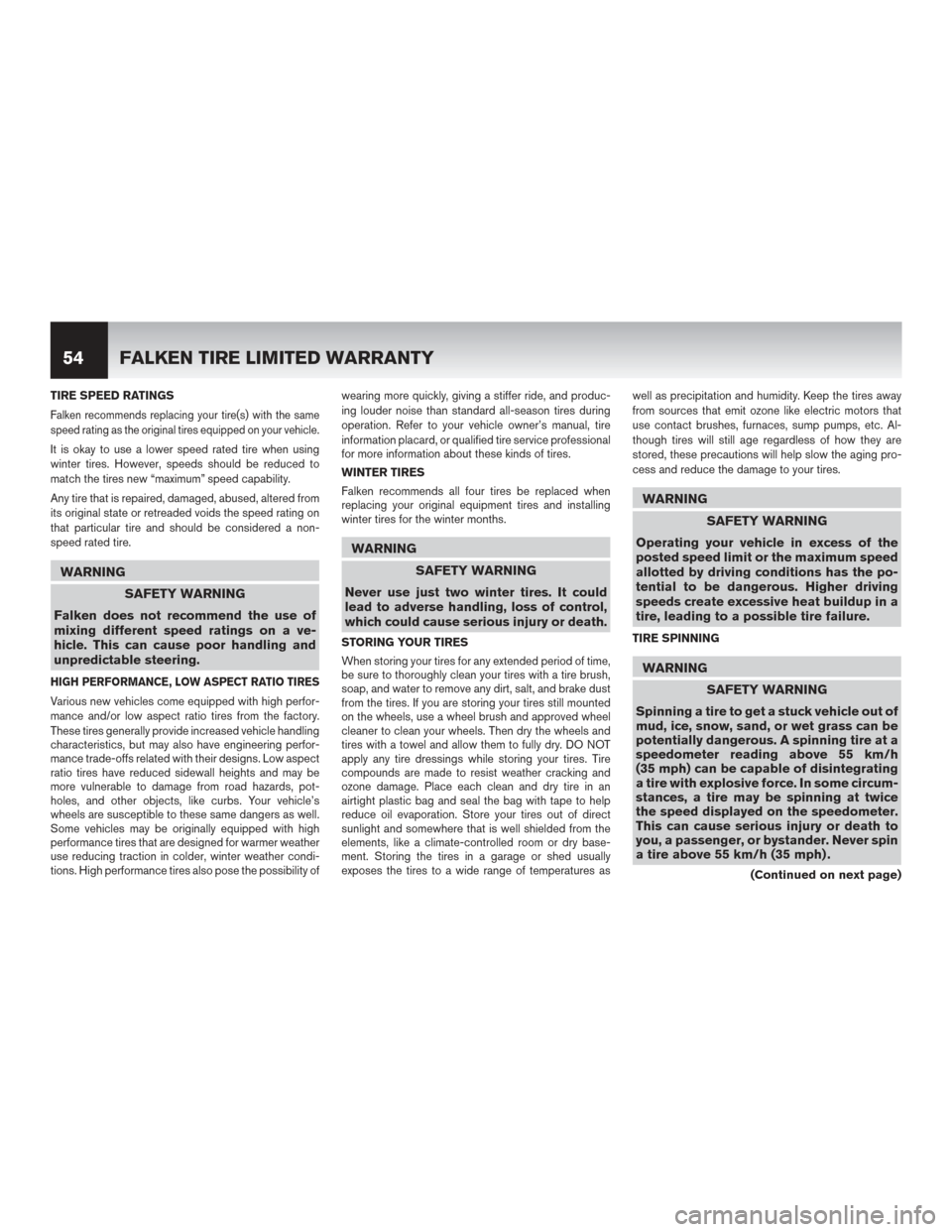
TIRE SPEED RATINGS
Falken recommends replacing your tire(s) with the same
speed rating as the original tires equipped on your vehicle.
It is okay to use a lower speed rated tire when using
winter tires. However, speeds should be reduced to
match the tires new “maximum” speed capability.
Any tire that is repaired, damaged, abused, altered from
its original state or retreaded voids the speed rating on
that particular tire and should be considered a non-
speed rated tire.
WARNINGSAFETY WARNING
Falken does not recommend the use of
mixing different speed ratings on a ve-
hicle. This can cause poor handling and
unpredictable steering.
HIGH PERFORMANCE, LOW ASPECT RATIO TIRES
Various new vehicles come equipped with high perfor-
mance and/or low aspect ratio tires from the factory.
These tires generally provide increased vehicle handling
characteristics, but may also have engineering perfor-
mance trade-offs related with their designs. Low aspect
ratio tires have reduced sidewall heights and may be
more vulnerable to damage from road hazards, pot-
holes, and other objects, like curbs. Your vehicle’s
wheels are susceptible to these same dangers as well.
Some vehicles may be originally equipped with high
performance tires that are designed for warmer weather
use reducing traction in colder, winter weather condi-
tions. High performance tires also pose the possibility of wearing more quickly, giving a stiffer ride, and produc-
ing louder noise than standard all-season tires during
operation. Refer to your vehicle owner’s manual, tire
information placard, or qualified tire service professional
for more information about these kinds of tires.
WINTER TIRES
Falken recommends all four tires be replaced when
replacing your original equipment tires and installing
winter tires for the winter months.
WARNING
SAFETY WARNING
Never use just two winter tires. It could
lead to adverse handling, loss of control,
which could cause serious injury or death.
STORING YOUR TIRES
When storing your tires for any extended period of time,
be sure to thoroughly clean your tires with a tire brush,
soap, and water to remove any dirt, salt, and brake dust
from the tires. If you are storing your tires still mounted
on the wheels, use a wheel brush and approved wheel
cleaner to clean your wheels. Then dry the wheels and
tires with a towel and allow them to fully dry. DO NOT
apply any tire dressings while storing your tires. Tire
compounds are made to resist weather cracking and
ozone damage. Place each clean and dry tire in an
airtight plastic bag and seal the bag with tape to help
reduce oil evaporation. Store your tires out of direct
sunlight and somewhere that is well shielded from the
elements, like a climate-controlled room or dry base-
ment. Storing the tires in a garage or shed usually
exposes the tires to a wide range of temperatures as well as precipitation and humidity. Keep the tires away
from sources that emit ozone like electric motors that
use contact brushes, furnaces, sump pumps, etc. Al-
though tires will still age regardless of how they are
stored, these precautions will help slow the aging pro-
cess and reduce the damage to your tires.
WARNING
SAFETY WARNING
Operating your vehicle in excess of the
posted speed limit or the maximum speed
allotted by driving conditions has the po-
tential to be dangerous. Higher driving
speeds create excessive heat buildup in a
tire, leading to a possible tire failure.
TIRE SPINNING
WARNING SAFETY WARNING
Spinning a tire to get a stuck vehicle out of
mud, ice, snow, sand, or wet grass can be
potentially dangerous. A spinning tire at a
speedometer reading above 55 km/h
(35 mph) can be capable of disintegrating
a tire with explosive force. In some circum-
stances, a tire may be spinning at twice
the speed displayed on the speedometer.
This can cause serious injury or death to
you, a passenger, or bystander. Never spin
a tire above 55 km/h (35 mph) .
(Continued on next page)
54 FALKEN TIRE LIMITED WARRANTY
Page 64 of 82
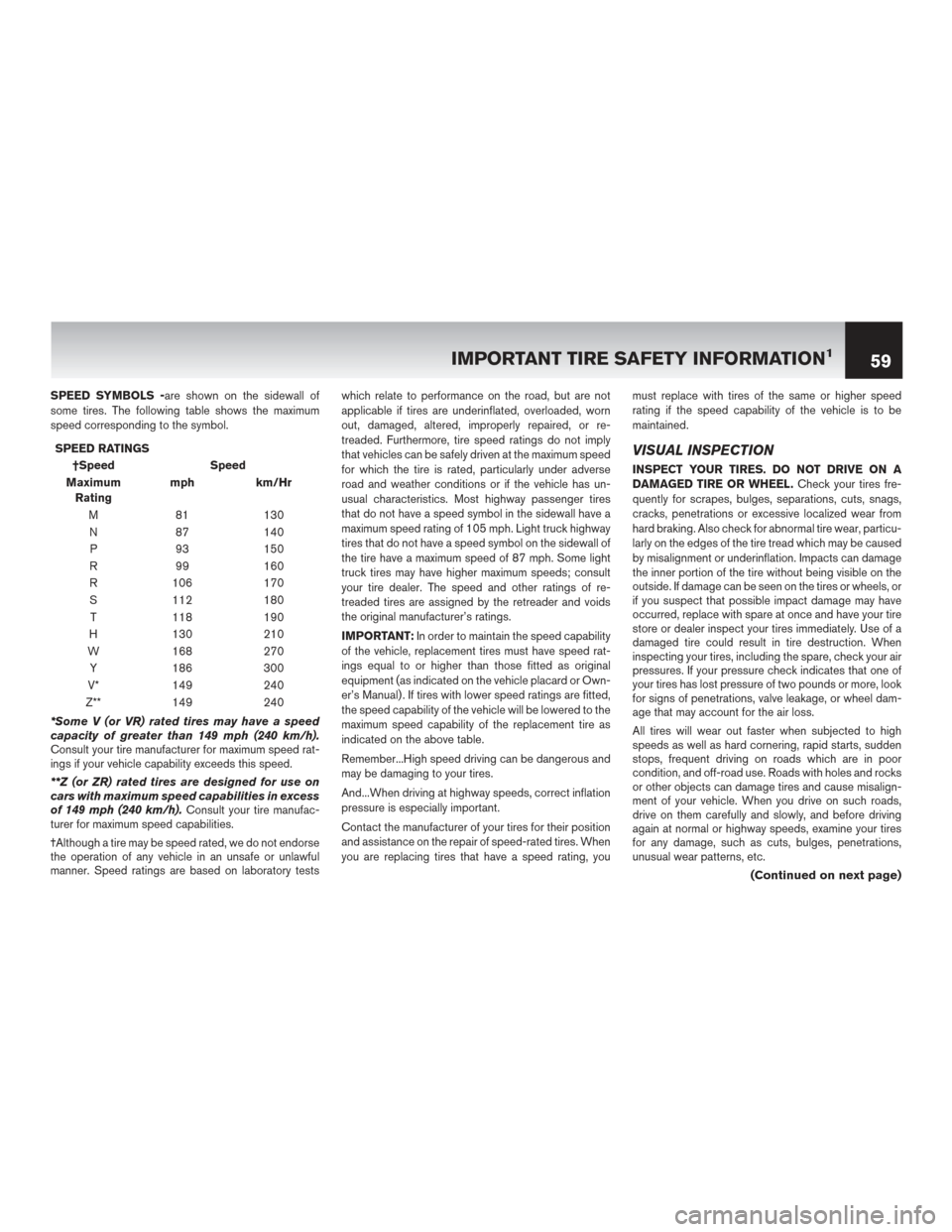
SPEED SYMBOLS -are shown on the sidewall of
some tires. The following table shows the maximum
speed corresponding to the symbol.SPEED RATINGS †Speed Speed
Maximum Rating mph km/Hr
M 81 130
N 87 140
P 93 150
R 99 160
R 106 170
S 112 180
T 118 190
H 130 210
W 168 270
Y 186 300
V* 149 240
Z** 149 240
*Some V (or VR) rated tires may have a speed
capacity of greater than 149 mph (240 km/h).
Consult your tire manufacturer for maximum speed rat-
ings if your vehicle capability exceeds this speed.
**Z (or ZR) rated tires are designed for use on
cars with maximum speed capabilities in excess
of 149 mph (240 km/h). Consult your tire manufac-
turer for maximum speed capabilities.
†Although a tire may be speed rated, we do not endorse
the operation of any vehicle in an unsafe or unlawful
manner. Speed ratings are based on laboratory tests which relate to performance on the road, but are not
applicable if tires are underinflated, overloaded, worn
out, damaged, altered, improperly repaired, or re-
treaded. Furthermore, tire speed ratings do not imply
that vehicles can be safely driven at the maximum speed
for which the tire is rated, particularly under adverse
road and weather conditions or if the vehicle has un-
usual characteristics. Most highway passenger tires
that do not have a speed symbol in the sidewall have a
maximum speed rating of 105 mph. Light truck highway
tires that do not have a speed symbol on the sidewall of
the tire have a maximum speed of 87 mph. Some light
truck tires may have higher maximum speeds; consult
your tire dealer. The speed and other ratings of re-
treaded tires are assigned by the retreader and voids
the original manufacturer’s ratings.
IMPORTANT:
In order to maintain the speed capability
of the vehicle, replacement tires must have speed rat-
ings equal to or higher than those fitted as original
equipment (as indicated on the vehicle placard or Own-
er’s Manual) . If tires with lower speed ratings are fitted,
the speed capability of the vehicle will be lowered to the
maximum speed capability of the replacement tire as
indicated on the above table.
Remember...High speed driving can be dangerous and
may be damaging to your tires.
And...When driving at highway speeds, correct inflation
pressure is especially important.
Contact the manufacturer of your tires for their position
and assistance on the repair of speed-rated tires. When
you are replacing tires that have a speed rating, you must replace with tires of the same or higher speed
rating if the speed capability of the vehicle is to be
maintained.
VISUAL INSPECTION
INSPECT YOUR TIRES. DO NOT DRIVE ON A
DAMAGED TIRE OR WHEEL.
Check your tires fre-
quently for scrapes, bulges, separations, cuts, snags,
cracks, penetrations or excessive localized wear from
hard braking. Also check for abnormal tire wear, particu-
larly on the edges of the tire tread which may be caused
by misalignment or underinflation. Impacts can damage
the inner portion of the tire without being visible on the
outside. If damage can be seen on the tires or wheels, or
if you suspect that possible impact damage may have
occurred, replace with spare at once and have your tire
store or dealer inspect your tires immediately. Use of a
damaged tire could result in tire destruction. When
inspecting your tires, including the spare, check your air
pressures. If your pressure check indicates that one of
your tires has lost pressure of two pounds or more, look
for signs of penetrations, valve leakage, or wheel dam-
age that may account for the air loss.
All tires will wear out faster when subjected to high
speeds as well as hard cornering, rapid starts, sudden
stops, frequent driving on roads which are in poor
condition, and off-road use. Roads with holes and rocks
or other objects can damage tires and cause misalign-
ment of your vehicle. When you drive on such roads,
drive on them carefully and slowly, and before driving
again at normal or highway speeds, examine your tires
for any damage, such as cuts, bulges, penetrations,
unusual wear patterns, etc.
(Continued on next page)
IMPORTANT TIRE SAFETY INFORMATION159
Page 65 of 82
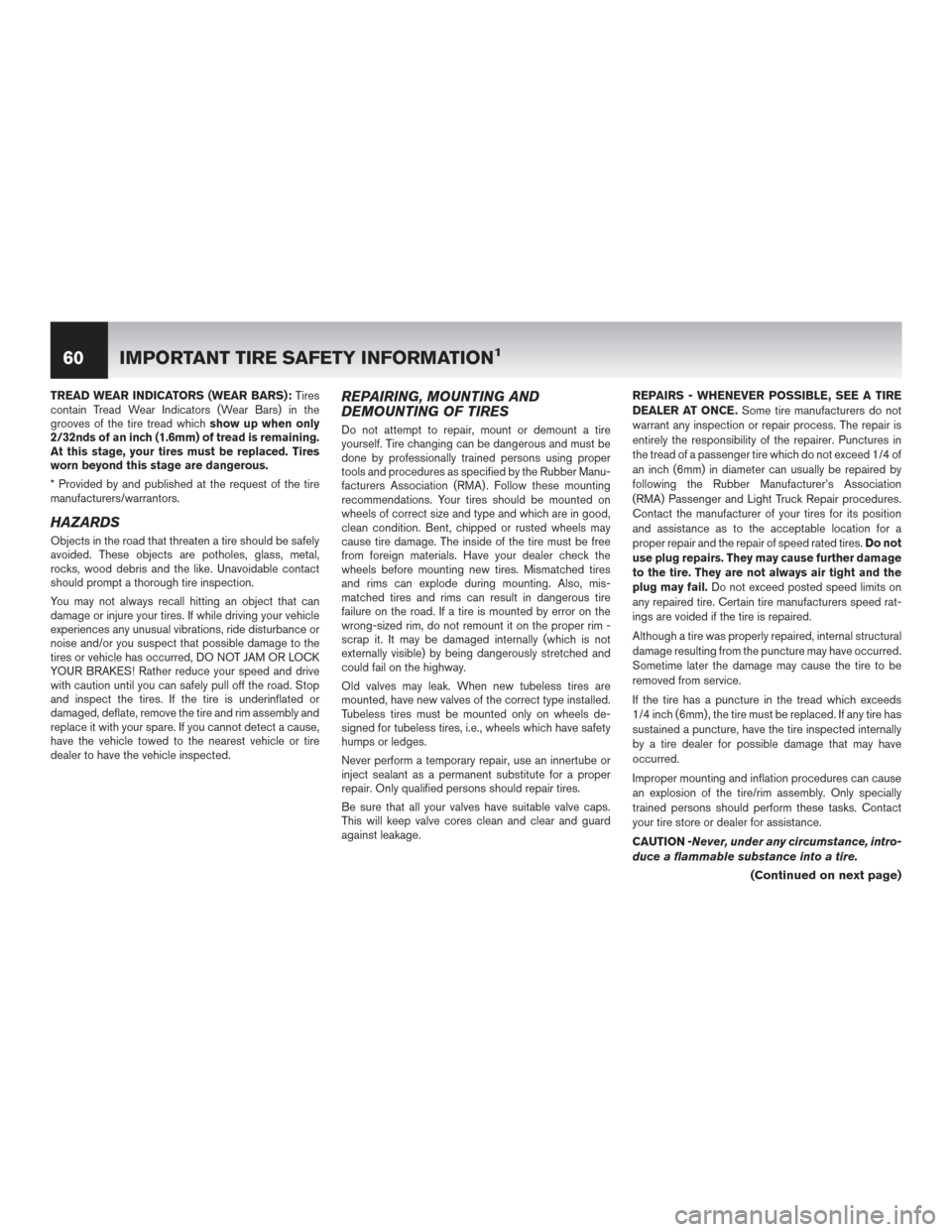
TREAD WEAR INDICATORS (WEAR BARS):Tires
contain Tread Wear Indicators (Wear Bars) in the
grooves of the tire tread which show up when only
2/32nds of an inch (1.6mm) of tread is remaining.
At this stage, your tires must be replaced. Tires
worn beyond this stage are dangerous.
* Provided by and published at the request of the tire
manufacturers/warrantors.
HAZARDS
Objects in the road that threaten a tire should be safely
avoided. These objects are potholes, glass, metal,
rocks, wood debris and the like. Unavoidable contact
should prompt a thorough tire inspection.
You may not always recall hitting an object that can
damage or injure your tires. If while driving your vehicle
experiences any unusual vibrations, ride disturbance or
noise and/or you suspect that possible damage to the
tires or vehicle has occurred, DO NOT JAM OR LOCK
YOUR BRAKES! Rather reduce your speed and drive
with caution until you can safely pull off the road. Stop
and inspect the tires. If the tire is underinflated or
damaged, deflate, remove the tire and rim assembly and
replace it with your spare. If you cannot detect a cause,
have the vehicle towed to the nearest vehicle or tire
dealer to have the vehicle inspected.
REPAIRING, MOUNTING AND
DEMOUNTING OF TIRES
Do not attempt to repair, mount or demount a tire
yourself. Tire changing can be dangerous and must be
done by professionally trained persons using proper
tools and procedures as specified by the Rubber Manu-
facturers Association (RMA) . Follow these mounting
recommendations. Your tires should be mounted on
wheels of correct size and type and which are in good,
clean condition. Bent, chipped or rusted wheels may
cause tire damage. The inside of the tire must be free
from foreign materials. Have your dealer check the
wheels before mounting new tires. Mismatched tires
and rims can explode during mounting. Also, mis-
matched tires and rims can result in dangerous tire
failure on the road. If a tire is mounted by error on the
wrong-sized rim, do not remount it on the proper rim -
scrap it. It may be damaged internally (which is not
externally visible) by being dangerously stretched and
could fail on the highway.
Old valves may leak. When new tubeless tires are
mounted, have new valves of the correct type installed.
Tubeless tires must be mounted only on wheels de-
signed for tubeless tires, i.e., wheels which have safety
humps or ledges.
Never perform a temporary repair, use an innertube or
inject sealant as a permanent substitute for a proper
repair. Only qualified persons should repair tires.
Be sure that all your valves have suitable valve caps.
This will keep valve cores clean and clear and guard
against leakage. REPAIRS - WHENEVER POSSIBLE, SEE A TIRE
DEALER AT ONCE.
Some tire manufacturers do not
warrant any inspection or repair process. The repair is
entirely the responsibility of the repairer. Punctures in
the tread of a passenger tire which do not exceed 1/4 of
an inch (6mm) in diameter can usually be repaired by
following the Rubber Manufacturer’s Association
(RMA) Passenger and Light Truck Repair procedures.
Contact the manufacturer of your tires for its position
and assistance as to the acceptable location for a
proper repair and the repair of speed rated tires. Do not
use plug repairs. They may cause further damage
to the tire. They are not always air tight and the
plug may fail. Do not exceed posted speed limits on
any repaired tire. Certain tire manufacturers speed rat-
ings are voided if the tire is repaired.
Although a tire was properly repaired, internal structural
damage resulting from the puncture may have occurred.
Sometime later the damage may cause the tire to be
removed from service.
If the tire has a puncture in the tread which exceeds
1/4 inch (6mm) , the tire must be replaced. If any tire has
sustained a puncture, have the tire inspected internally
by a tire dealer for possible damage that may have
occurred.
Improper mounting and inflation procedures can cause
an explosion of the tire/rim assembly. Only specially
trained persons should perform these tasks. Contact
your tire store or dealer for assistance.
CAUTION -Never, under any circumstance, intro-
duce a flammable substance into a tire.
(Continued on next page)
60 IMPORTANT TIRE SAFETY INFORMATION1
Page 71 of 82
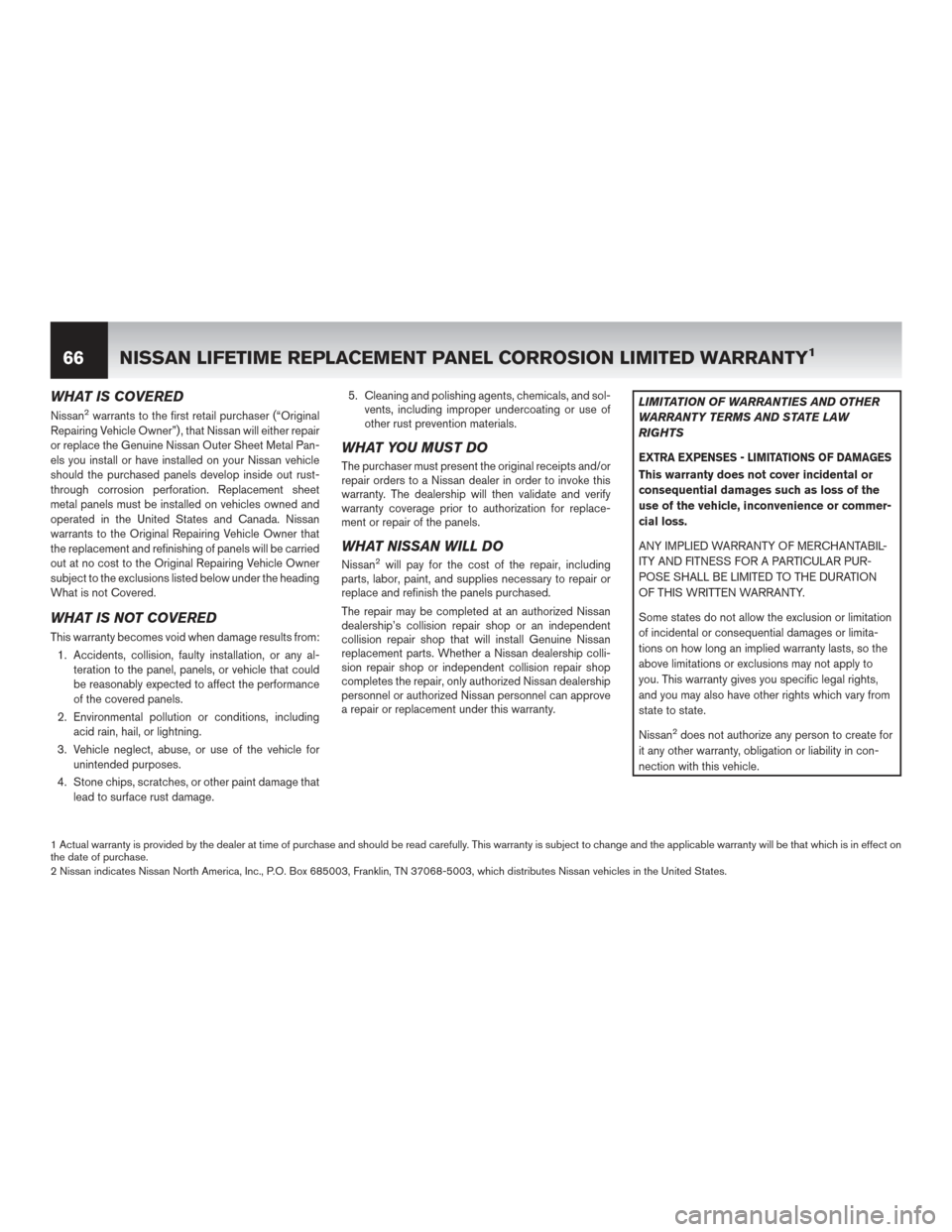
WHAT IS COVERED
Nissan2warrants to the first retail purchaser (“Original
Repairing Vehicle Owner”) , that Nissan will either repair
or replace the Genuine Nissan Outer Sheet Metal Pan-
els you install or have installed on your Nissan vehicle
should the purchased panels develop inside out rust-
through corrosion perforation. Replacement sheet
metal panels must be installed on vehicles owned and
operated in the United States and Canada. Nissan
warrants to the Original Repairing Vehicle Owner that
the replacement and refinishing of panels will be carried
out at no cost to the Original Repairing Vehicle Owner
subject to the exclusions listed below under the heading
What is not Covered.
WHAT IS NOT COVERED
This warranty becomes void when damage results from:
1. Accidents, collision, faulty installation, or any al- teration to the panel, panels, or vehicle that could
be reasonably expected to affect the performance
of the covered panels.
2. Environmental pollution or conditions, including acid rain, hail, or lightning.
3. Vehicle neglect, abuse, or use of the vehicle for unintended purposes.
4. Stone chips, scratches, or other paint damage that lead to surface rust damage. 5. Cleaning and polishing agents, chemicals, and sol-
vents, including improper undercoating or use of
other rust prevention materials.
WHAT YOU MUST DO
The purchaser must present the original receipts and/or
repair orders to a Nissan dealer in order to invoke this
warranty. The dealership will then validate and verify
warranty coverage prior to authorization for replace-
ment or repair of the panels.
WHAT NISSAN WILL DO
Nissan2will pay for the cost of the repair, including
parts, labor, paint, and supplies necessary to repair or
replace and refinish the panels purchased.
The repair may be completed at an authorized Nissan
dealership’s collision repair shop or an independent
collision repair shop that will install Genuine Nissan
replacement parts. Whether a Nissan dealership colli-
sion repair shop or independent collision repair shop
completes the repair, only authorized Nissan dealership
personnel or authorized Nissan personnel can approve
a repair or replacement under this warranty.
LIMITATION OF WARRANTIES AND OTHER
WARRANTY TERMS AND STATE LAW
RIGHTS
EXTRA EXPENSES - LIMITATIONS OF DAMAGES
This warranty does not cover incidental or
consequential damages such as loss of the
use of the vehicle, inconvenience or commer-
cial loss.
ANY IMPLIED WARRANTY OF MERCHANTABIL-
ITY AND FITNESS FOR A PARTICULAR PUR-
POSE SHALL BE LIMITED TO THE DURATION
OF THIS WRITTEN WARRANTY.
Some states do not allow the exclusion or limitation
of incidental or consequential damages or limita-
tions on how long an implied warranty lasts, so the
above limitations or exclusions may not apply to
you. This warranty gives you specific legal rights,
and you may also have other rights which vary from
state to state.
Nissan
2does not authorize any person to create for
it any other warranty, obligation or liability in con-
nection with this vehicle.
1 Actual warranty is provided by the dealer at time of purchase and should be read carefully. This warranty is subject to change and the applicable warranty will be that which is in effect on
the date of purchase.
2 Nissan indicates Nissan North America, Inc., P.O. Box 685003, Franklin, TN 37068-5003, which distributes Nissan vehicles in the United States.
66 NISSAN LIFETIME REPLACEMENT PANEL CORROSION LIMITED WARRANTY1
Page 79 of 82
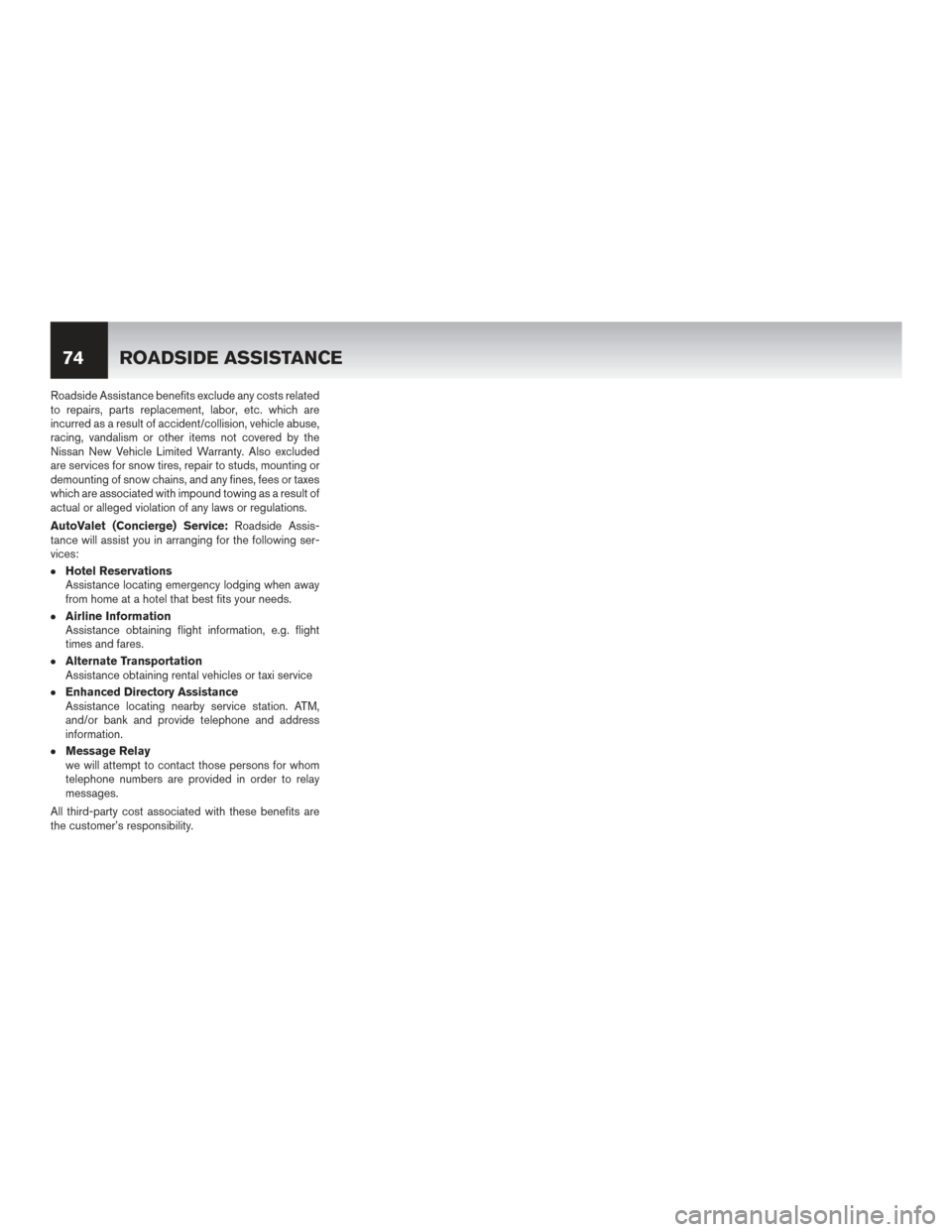
Roadside Assistance benefits exclude any costs related
to repairs, parts replacement, labor, etc. which are
incurred as a result of accident/collision, vehicle abuse,
racing, vandalism or other items not covered by the
Nissan New Vehicle Limited Warranty. Also excluded
are services for snow tires, repair to studs, mounting or
demounting of snow chains, and any fines, fees or taxes
which are associated with impound towing as a result of
actual or alleged violation of any laws or regulations.
AutoValet (Concierge) Service:Roadside Assis-
tance will assist you in arranging for the following ser-
vices:
●Hotel Reservations
Assistance locating emergency lodging when away
from home at a hotel that best fits your needs.
●Airline Information
Assistance obtaining flight information, e.g. flight
times and fares.
●Alternate Transportation
Assistance obtaining rental vehicles or taxi service
●Enhanced Directory Assistance
Assistance locating nearby service station. ATM,
and/or bank and provide telephone and address
information.
●Message Relay
we will attempt to contact those persons for whom
telephone numbers are provided in order to relay
messages.
All third-party cost associated with these benefits are
the customer’s responsibility.
74 ROADSIDE ASSISTANCE